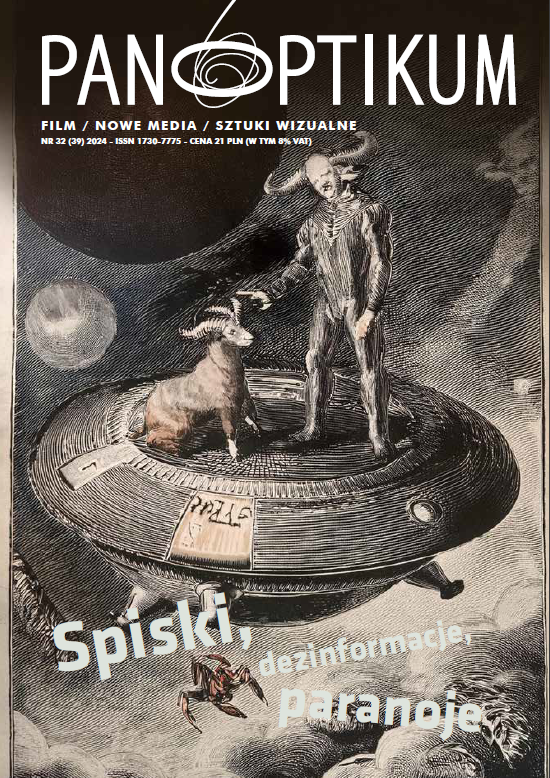Bomba atomowa – piękna, straszna, Dobra i Zła. O filmie dokumentalnym The Atomic Cafe (1982, reż. J. Loader, P. Rafferty, K. Rafferty)
DOI:
https://doi.org/10.26881/pan.2024.32.03Słowa kluczowe:
bomba atomowa, propaganda, found footage, film dokumentalnyAbstrakt
The Atomic Cafe (1982), a work directed by Jayne Loader, Kevin Rafferty and Pierce Rafferty, is undoubtedly one of the most interesting works of documentary cinema of the 1980s. What the archives (collected over the years and coming from very different sources: military training films, materials commissioned by the US government, television reports, newsreels, street surveys, etc.) have in common is the fact that they constitute a unique testimony of a historical moment. In a broader sense: they document the beginnings of the Cold War. In a narrower sense: the archives are about American propaganda in the context of the atomic bomb – the „our” American bomb (which is – the materials suggest – useful and almost of divine provenance), and the „foreign” Soviet bomb (which is – again, as the archives indicate – destructive and atrocious). In this paper, I examine how the directors of The Atomic Cafe reconstructed this – necessarily internally fractured – narrative about the nuclear weapons.
Downloads
Bibliografia
Baron, J. (2014). The Archive Effect. Found Footage and the Audiovisual Experience of History. London–New York: Routledge.
Boyer, P.S. (1985). By the Bomb’s Early Light: American Thought and Culture at the Dawn of the Atomic Age. New York: Pantheon Books.
Canby, V. (1982). Documentary on Views about Atom Bomb. „The New York Times”, March 17.
Danielewska, J. (2008). Amerykański system obrony przeciwrakietowej – cele, koncepcje, umiejscowienie. „Bezpieczeństwo. Teoria i Praktyka”, nr 1–2.
Dowling, J. (1979). Paul Jacobs and the Nuclear Gang. „Bulletin of the Atomic Scientists”, Vol. 35, No. 10.
Ebert, R. (1982). “The Atomic Café”. https://www.rogerebert.com/reviews/theatomic-cafe-1982 (dostęp: 28.05.2024).
Genzlinger, N. (2020). Kevin Rafferty, ‘Atomic Cafe’ Co-Director, Dies at 73. „The New York Times”, July 7.
Glas, F. (1983). “Atomic Cafe”. „Film Quarterly”, Vol. 36, No. 3.
Glausiusz, J. (2006). Selling Paranoia to the People. „Discover”, Vol. 27, Issue 3.
Gomułka, W., Rewerski, W. (red.) (2000). Encyklopedia zdrowia, t. 1. Warszawa: Wydawnictwo Naukowe PWN.
Gordin, M.D. (2010). Truman, Stalin i koniec monopolu atomowego, przeł. T. Markowski. Warszawa: Prószyński i S-ka.
Haratyk, P. (2011). Found footage: o niezwykłym uroku „obrazów z odzysku”. „Ekrany”, nr 3–4.
Harrington, R. (1982). “Atomic” Filmmakers: Trio With a Point of View. https://www.
washingtonpost.com/archive/lifestyle/1982/05/14/atomic-filmmakers-trio-witha-
point-of-view/a9e1e51c-7672-4282-aeb4-83df5441260f/ (dostęp: 10.02.2023).
Herman, R. (1982). They Turned Old Movies Into A Timely Film About Nuclear War. „The New York Times”, May 16.
Hill, D. (1982). “Hurry Tomorrow”: The Forced Drugging of Mental Patients. „Humanity & Society”, Vol. 6, No. 2.
KAPPA [właśc. Tadeusz Karpowski] (1967). Głosy i glosy. Film montażowy. „Film”, nr 11.
Kino Lorber – „The Atomic Cafe” (2018) [broszura prasowa]. https://kinolorberbucket.s3.amazonaws.com/production/documents/The%20Atomic%20Cafe%20%E2%80%93%20Press%20Kit.pdf (dostęp: 20.02.2024).
Krajewski, P. (2009). Obrazy z recyklingu, obrazy z odzysku. Remiks, sampling, scratching… O kinie found footage, [w:] V. Kutlubasis-Krajewska, P. Krajewski (red.), Widok. WRO Media Art Reader. Od kina absolutnego do filmu przyszłości. Materiały z historii eksperymentu w sztuce ruchomego obrazu. Wrocław: WRO Art Center.
Labandeira, S. (2023). Old Footage, New Meanings: The Case of “The Atomic Cafe”, [w:] N. Erdoğan, E. Kayaalp (red.), Exploring Past Images in a Digital Age: Reinventing the Archive. Amsterdam: Amsterdam University Press.
Loader, J. (1997). Interview – Jayne Loader. https://www.metamute.org/editorial/articles/interview-jayne-loader (dostęp: 10.09.2024).
Loska, K. (2018). Współczesny horror w przebraniu kina „found footage”. „Kwartalnik Filmowy”, nr 104.
Miscamble, W.D. (2007). From Roosevelt to Truman: Potsdam, Hiroshima and the Cold War. Cambridge: Cambridge University Press.
Nichols, B. (2013). Typy filmu dokumentalnego, przeł. M. Heberle, D. Rode, [w:] D. Rode, M. Pieńkowski (red.), Metody dokumentalne w filmie. Łódź: Wydawnictwo Biblioteki Państwowej Wyższej Szkoły Filmowej, Telewizyjnej i Teatralnej.
Pastusiak, L. (1988). Ronald Reagan. Biografia dokumentacyjna. Warszawa: Krajowa Agencja Wydawnicza.
Pike, D.L. (2021). Cold War Space and Culture in the 1960s and 1980s. The Bunkered Decades. Oxford: Oxford University Press.
Raza Rizvi, W. (2015). “The Atomic Cafe” (1982): Looking Back at Nuclear Paranoia form the 80s to the 50s in a Cold War Classic. „Eye Magazine”, No. 8.
Saito, S. (2018). Interview: Kevin Rafferty, Pierce Rafferty and Jayne Loader on Reigniting “The Atomic Cafe”. https://moveablefest.com/kevin-pierce-rafferty-jayneloader-atomic-cafe/ (dostęp: 14.04.2024).
Sklar, R., Davis, P. [dwugłos] (1979). The Sorrow and the Pity of Non-Fiction Film. „Nation”, Vol. 228, No. 9.
Wees, W.C. (1993). Recycled Images. The Art and Politics of Found Footage Films. New York: Anthology Film Archives.
Wiener, J. (2007). The Omniscient Narrator and the Unreliable Narrator: The Case of “Atomic Café”. „Film & History”, Vol. 37.1.
Wittner, L.S. (2009). Confronting the Bomb. A Short History of the World Nuclear Disarmament Movement. Redwood City CA: Stanford University Press.
Zarychta, S. (2016). Broń jądrowa w kształtowaniu bezpieczeństwa 1945–2015. Warszawa: Bellona.
Zyblikiewicz, L. (2004). USA. Warszawa: Wydawnictwo Trio.

 Uniwersyteckie Czasopisma Naukowe
Uniwersyteckie Czasopisma Naukowe









